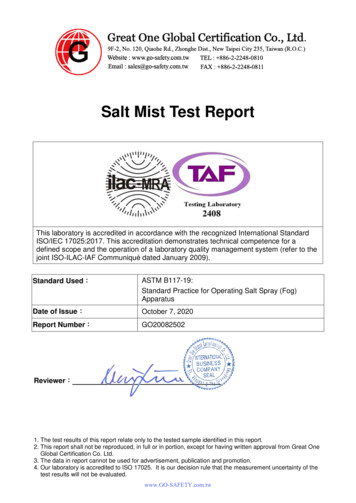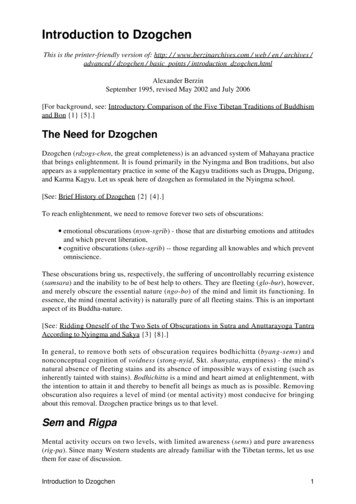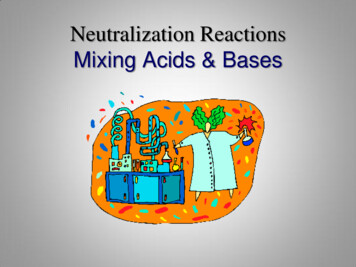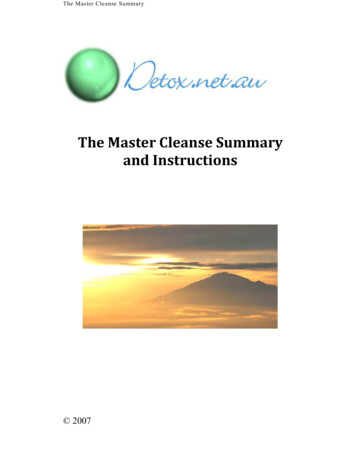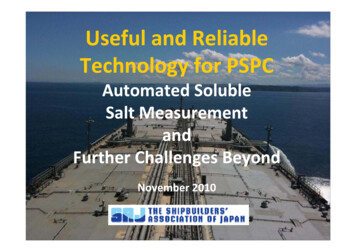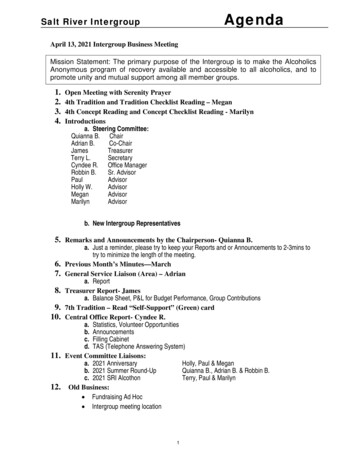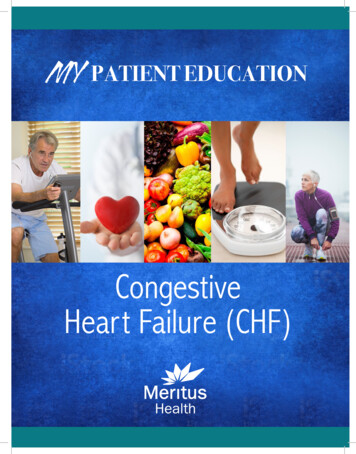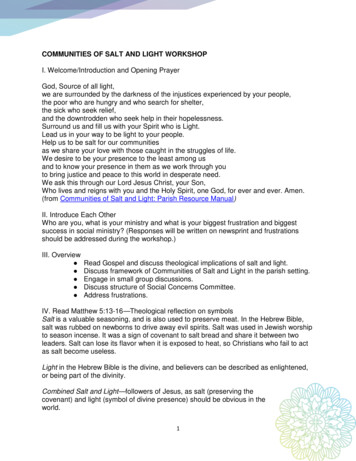
Transcription
COMMUNITIES OF SALT AND LIGHT WORKSHOPI. Welcome/Introduction and Opening PrayerGod, Source of all light,we are surrounded by the darkness of the injustices experienced by your people,the poor who are hungry and who search for shelter,the sick who seek relief,and the downtrodden who seek help in their hopelessness.Surround us and fill us with your Spirit who is Light.Lead us in your way to be light to your people.Help us to be salt for our communitiesas we share your love with those caught in the struggles of life.We desire to be your presence to the least among usand to know your presence in them as we work through youto bring justice and peace to this world in desperate need.We ask this through our Lord Jesus Christ, your Son,Who lives and reigns with you and the Holy Spirit, one God, for ever and ever. Amen.(from Communities of Salt and Light: Parish Resource Manual)II. Introduce Each OtherWho are you, what is your ministry and what is your biggest frustration and biggestsuccess in social ministry? (Responses will be written on newsprint and frustrationsshould be addressed during the workshop.)III. Overview Read Gospel and discuss theological implications of salt and light.Discuss framework of Communities of Salt and Light in the parish setting.Engage in small group discussions.Discuss structure of Social Concerns Committee.Address frustrations.IV. Read Matthew 5:13-16—Theological reflection on symbolsSalt is a valuable seasoning, and is also used to preserve meat. In the Hebrew Bible,salt was rubbed on newborns to drive away evil spirits. Salt was used in Jewish worshipto season incense. It was a sign of covenant to salt bread and share it between twoleaders. Salt can lose its flavor when it is exposed to heat, so Christians who fail to actas salt become useless.Light in the Hebrew Bible is the divine, and believers can be described as enlightened,or being part of the divinity.Combined Salt and Light—followers of Jesus, as salt (preserving thecovenant) and light (symbol of divine presence) should be obvious in theworld.1
V. Communities of Salt and LightGive out copies of synopsis below, and discuss.VI. Small Group WorkGive out questions below. Each group should consist of three to four people. Adultslearn best through practical experience, so invite them to discuss common issues andsolutions. They will then share with the group the main commonalities.Social Concerns Committee1. Ask whose parishes have social concerns/social justice/social ministrycommittees. The people from parishes with committees will have much to offerby drawing upon their experiences in this part of the session.2. Describe the difference between “Doers” and “Organizers.”o Doers make sure specific tasks get done by putting solutions into action. Theyare energetic and dedicated to completing a task, learning new ministry skills,continuing with ongoing formation, and providing ideas to shape planning.Ideally, they visit the homebound, write letters to legislators, participate inmission trips, i.e., travel to Haiti and other developing countries, etc.o Organizers are strategic planners. They recruit leaders, bring people together,develop skills and formation in others, and facilitate problem-solvingdiscussions and meetings. They are good listeners and communicators, andensure social ministry is woven through liturgy and create effective systems ofcommunication in social ministry. They serve as good liaisons with the churchstaff.3. Describe how to recruit and organize a core committee.4. Address problem-solving regarding frustrations participants shared and recordedon newsprint at the beginning of the workshop.VIII. Closing PrayerTo have hope is to believe that history continues, open to the dream of God and tohuman creativity. To have hope is to continue affirming that it is possible to dream of adifferent world, without hunger, without injustice, without discrimination. To have hope isto be a courier of God and a courier of men and women of goodwill, tearing down walls,overcoming borders, building bridges. To have hope is to believe in the revolutionarypotential of faith is to leave the door open so that the Spirit can enter and make allthings new. To have hope is to believe that life wins over death. To have hope is tobegin again as many times as necessary. To have hope is to believe that hope is notthe last thing that dies. To have hope is to believe that hope cannot die, that hope nolonger dies. To have hope is to live. Amen.2
(Missionary Sisters of St. Charles Boromeo- Scalabrinians, Honduras; Prayer WithoutBorders: Celebrating Global Wisdom, CRS)Remind people of resource materials (see below).Communities of Salt and Light SummationI. Anchoring Social Ministry: Prayer and WorshipIt is in the liturgy that we find the fundamental direction, motivation and strength forsocial ministry. Social ministry not genuinely rooted in prayer can easily burn itself out.II. Sharing the Message: Preaching and EducationWe are called to share our social teaching more effectively in our parishes than wehave. Our social doctrine is an integral part of our faith; we need to pass it on clearly,creatively and consistently. We urge those who preach not to ignore the regularopportunities provided by the liturgy to connect our faith and our everyday lives, and toshare biblical values on justice and peace. Our social doctrine must also be an essentialpart of the curriculum and life of our schools, religious education programs, sacramentalpreparation and Christian initiation activities.III. Supporting the Salt of the Earth: Family, Work, CitizenshipOur parishes need to encourage, support and sustain lay people in living their faith inthe family, neighborhood, marketplace and public arena. It is lay women and men,placing their gifts at the service of others. The most challenging work for justice is notdone in church committees, but in the secular world of work, family life and citizenship.IV. Serving the Least of These: Outreach and CharityParishes are called to reach out to the hurting, the poor and the vulnerable in our midstin concrete acts of charity. Thousands of food pantries hundreds of shelters anduncounted outreach programs for poor families, refugees, the elderly and others in needare an integral part of parish life.V. Advocating for Justice: Legislative ActionParishes as local institutions have special opportunities to develop leaders, to promotecitizenship, and to provide forums for discussion and action on public issues. The voicesof parishioners need to be heard on behalf of vulnerable children, born and unborn; onbehalf of those who suffer discrimination and injustice; on behalf of those without healthcare or housing; on behalf of our land and water; and on behalf of our communities andneighborhoods.VI. Creating Community: Organizing for JusticeParish leaders are taking the time to listen to the concerns of their members and areorganizing to act on those concerns. Parish participation in such community effortsprovides concrete handles to deal with key issues and builds the capacity of the parishto act on our values.3
VII. Building Solidarity: Beyond Parish BoundariesParishes need to be bridge-builders, reminding us that we are part of a UniversalChurch with ties of faith and humanity to sisters and brothers all over the world.Programs of parish twinning, support for Catholic Relief Services, mission efforts,migration and refugee activities and other global ministries are signs of solidarity in ashrinking and suffering world. Advocacy on human rights, development and peacethrough legislative networks and other efforts are also signs of a faith withoutboundaries and a parish serious about its social responsibilities.What we have learned:1. Social ministry is rooted in faith.2. Respect for diversity in ministry: racially, ethnically, economically andideologically.3. While social justice is a task for every believer, strengthening ParishSocial Ministry depends on the skill and commitment of the parishleaders—to preach, participate, set priorities, and help with collaborationin bringing liturgy, formation, outreach and action into a common missionfor the church.4. Need links to diocesan and national structures for resources and training,and to connect with other structures of opportunity.5. Practice what we preach—live as we mean to.6. There is a danger of isolation for the few who work toward social justice:look for common ground and build capacity.Assessment questions for your parish:1. Where does the social mission fit in the life of your parish? Is it an integralpart of your community of faith or the work of a few?2. Do your liturgies include prayers for justice and peace, for the poor andthe vulnerable, in the context of the parish’s mission?3. How often have you noted “justice,” “mercy,” “fidelity” and “truth” inhomilies or in prayer?4. Is Catholic social teaching being taught in your parish schools, CCD andRCIA? Is it noted in the bulletin?5. How does your parish encourage parishioners to provide leadership inunions, business and professional associations, community groups andpolitical organizations?6. What is your parish currently doing to serve local needs or supportorganizations that serve them in your faith community? In the broadercommunity?7. How does your parish offer opportunities for members to learn about themoral dimensions of public policy issues affecting the poor andvulnerable?8. Does your parish have knowledge of community-based economicdevelopment and/or community organizing activities nearby?4
Social Justice ResourcesCatholic Social Teaching Resources: www.educationforjustice.org—membership onlyParish Social Ministry Resources: Amen, Ann. Jumpstart Your Parish Social Ministry with Parish Care andConcern. Catholic Charities, Diocese of Erie, 1996. (a direct service model) Catholic Campaign for Human Development. “Sharing the Tradition/Shaping theFuture” series. Catholic Campaign for Human Development, NCCB/USCCB,1991-1996 Durbin, Mary Ellen, et al. The Empowerment Process: Centering Social Ministryin the Life of the Local Christian Community. Paulist, 1994 (strong on communityorganizing) Flynn, Anne E. Dare to Believe, Dare to Act: A Parish Formation Program forMinistry and Service to Others. The Liturgical Press, 1997 (developed at St.Joseph, Cockeysville, MD, particularly useful to large, highly structured parishes) Heins, Peggy Prevoznik. Salt and Light: A Leadership Training Manual &Facilitator’s Supplement. Catholic Charities, Inc., Diocese of Wilmington, 1995 Kreitemeyer, Ron. Social Ministry: A Parish Planning Workbook. NationalPastoral Life Center/St. Anthony Messenger Press, 1998 Office of Social Concerns/Parish Relations. “Legislative Education Group:Shaping Our Future” (Parish Contact Edition). Catholic Charities, Archdiocese ofBaltimore, 19995
success in social ministry? (Responses will be written on newsprint and frustrations should be addressed during the workshop.) III. Overview Read Gospel and discuss theological implications of salt and light. Discuss framework of Communities of Salt and Light


